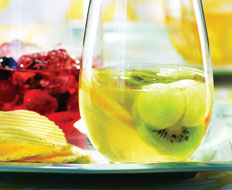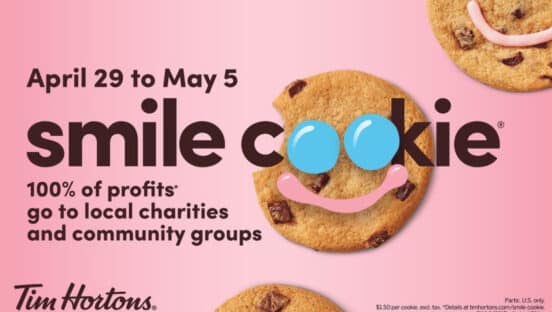For most American restaurants, tea had become something of an afterthought among nonalcoholic beverages.
Sure, tea is the world’s No. 2 beverage, second only to water. But as quick-service and fast-casual eateries focused on the expanding number of carbonated drinks and growing interest in coffee mixtures, tea was seen as a boring, necessary part of the menu.
These days, however, tea is hot, so to speak, and not just in teahouses. Restaurants’ tea sales have picked up briskly, especially as more units offer sweet tea, and traditional coffee houses are increasingly expanding their tea offerings.
“We’re seeing tea sales grow, and you can’t look past McDonald’s, or Subway, or any of the quick-service restaurants,” says Joe Simrany, president of the Tea Association of the USA Inc.
“They’re embracing tea like we haven’t seen in a long, long time.”
Consumers are “looking for more natural, more healthy alternatives,” and that is fueling the interest in different varieties and flavors of fresh brewed teas, he says. “People overdosed on carbonated soft drinks, and iced tea is benefiting from that.”
Almost all the tea sold in the U.S. is grown outside the country, and the Tea Association estimates tea imports grew more than 10 percent in 2010 over the previous year. Foodservice tea sales have been rising 3–5 percent annually in recent years.
More anecdotal evidence was the number of companies, nearly 50, exhibiting tea products at the annual National Restaurant Association Show in Chicago in May.
“People want an alternative beverage that is refreshing, with great taste, and that is healthy,” says Toby Tomblin, vice president and director of food innovations and ingredients at S&D Coffee Inc., which supplies restaurants with coffee and custom teas.
“Tea is a pretty natural product,” he adds, rich in antioxidants “with clean labels and a short ingredients list.”
In fact, tea accounted for 15.2 percent of restaurant beverage menu items during the fourth quarter of 2010, making it the third most-available type of nonalcoholic beverage at eateries, according to research firm Mintel.
The number of tea beverages offered at restaurants grew 11.2 percent from 2008 to 2010.
“Everyone’s trying to branch out beyond carbonated beverages,” says Kathy Hayden, foodservice analyst at Mintel. “Just as good coffee has become a requirement now for restaurants, operators are looking to do the same with tea.”
Tea provides an inexpensive alternative, she says, and “you can make a signature drink with just one flavor.”
Tomblin says flavors can be applied to the tea leaves before brewing or can be applied to the brewed tea afterward.
“You can get just about any flavor you want,” he says.
Consumption of tea, derived from certain shrubs and small trees in eastern and central Asia, dates back 5,000 years. It is grouped by various production and curing techniques, with six basic classifications: black, green, white, oolong, yellow, and post-fermented.
Black tea is the most common variety in North America, accounting for about 90 percent of all tea sales. The term comes from its color, which is the result of the leaves being fully oxidized. The tea became a popular trade item because it retains its flavor for years.
Green tea has grown in popularity in recent years because of its supposed health benefits, although the unwilted, unoxidized tea generally loses its flavor within a year.
White tea uses young leaves that are wilted and unoxidized, while yellow tea is unwilted and unoxidized, but with a slower drying phase than green tea. Oolong, which also is gaining in popularity, is wilted under strong sun and partially oxidized.
Similar to wine, different types of tea take their names from the districts where they’re grown, and each area is known for producing brews with a unique flavor and character.
By far, most tea consumed in the U.S. is the iced variety. Mintel research determined that 39 percent of restaurant-goers drink cold tea, about twice as many that have hot tea.
Additionally, a report by research and consulting firm Technomic Inc. found that 10 percent of restaurant consumers are drinking more iced tea than just two years ago, despite a 7 percent increase in prices during that same period.
For many years, quick-service tea didn’t always focus on quality, but that has been changing in recent years, as fresh-brewed tea, often made several times a day, became the norm.
Some fast feeders have their own blends of teas, while others use national brands. Subway, for instance, is using a fresh-brewed version of Coca Cola’s Fuze. Other quick serves and fast casuals offer bottled teas in refrigerated cases.
Technology has also helped bring better fresh-brewed iced tea to restaurants. One new idea is the Teafinity Brewmaster system developed by S&D Coffee.
Teafinity Brewmaster was one of the winners of the first Food & Beverage Product Innovations Awards showcased at the NRA Show.
The two-part system uses a liquid tea concentrate and a new dispensing system that delivers the look and taste of consistent, high-quality, fresh-brewed tea.
The flavor comes from real tea leaves and the brewing process is similar to steeping tea, Tomblin says. “It’s all about the correct amount of raw tea, the correct temperature of the water, and the correct dilution level.”
The resulting concentrate is packaged, placed into the machine, and mixed with fresh filtered water to create the final product. To customers, the Brewmaster looks like a typical tea dispenser.
[pagebreak]
The biggest growth in iced tea is in the sweet tea category, thanks in no small part to the decision by McDonald’s to begin serving it nationwide in 2008.
Of course, sweet tea is a staple at restaurants in the South, including many quick-service companies like Charlotte, North Carolina–based Bojangles’ Famous Chicken ’n Biscuits. In fact, the beverage is “in our DNA,” says company executive vice president Eric Newman.
“It’s the same recipe as when we began” in 1977, he says, even though the chain has grown to more than 500 restaurants in 10 states.
Sweet tea is made “the old-fashioned way,” sweetened with pure cane sugar, Newman says. “We not only brew it, but steep it, prime it, and limit its holding time.” As a result, fresh batches of the tea are made several times a day.
The strong performance of sweet tea at Bojangles’ and other quick serves in the South led McDonald’s franchisees in the Raleigh, North Carolina, region to develop a company-approved sweet tea offering.
McDonald’s officials saw a national beverage opportunity.
“We’ve been working hard to be a beverage destination,” and sweet tea seemed perfect, says company spokeswoman Ashlee Yingling. The regional favorite went through tests in other parts of the country before it was eventually rolled out nationwide.
The result: “It is a hit,” Yingling says. It also sells for $1 for a 32-ounce serving in many markets, helping to make sweet tea the least expensive restaurant beverage other than water, with an industry average of $1.83 per serving, according to Mintel.
Sweet and unsweetened teas make up about 90 percent of iced tea sales, Tomblin says. The rest are largely fruit-flavored teas, which are popular outside the South. Raspberry and peach are the most popular flavors.
Wendy’s used flavored iced tea to expand its overall summer seasonal menu. The Wild Berry Tea, made with blackberries, strawberries, and raspberries, complemented the Berry Almond Chicken Salad and Wild Berry Frosty Shake.
Numerous snack chains from Jamba Juice to Red Mango regularly feature tea in cold drinks, often extolling its health benefits to market the items. Overall, Chai and green tea tie for the top specialty flavor, each at about 10 percent, Technomic reports.
Iced tea has been the main product made by China Mist, a Scottsdale, Arizona–based manufacturer that worked with numerous restaurants, including Panda Express and Noodles & Co., to develop tea offerings.
The company is known for its whole-leaf iced teas and for using large tea leaves.
“All of it is hand-picked, so we get the larger leaves,” says China Mist president Joe Jacober. “That helps in the final product, because the big leaves are a great carrier for flavor and you get all the health benefits from these bigger leaves.”
The company also makes a concentrate from the same leaves.
In the past few years, China Mist has added a hot tea line, including steeped whole leaf tea, regular tea bags, and a teapot program called Sachet, which employs a larger tea bag that can brew 20 ounces. About 85 percent of the hot tea items are organic.
“Tea has become one of those things that restaurants can use to differentiate themselves, to be special,” Jacober says. “Everybody has basically the same carbonated drinks, but tea allows operators to create that unique experience.”
Another special tea product, Chai—made by boiling tea leaves with milk, sugar, and often spices—has been a hot and cold tea offering for several years at Caribou Coffee. It is also the foundation of the company’s effort to redefine and re-energize its tea menu.
“In the past year, one of the key things we’re doing is bringing to the tea platform what we do in coffee,” says Alfredo Martel, senior vice president of marketing and product management for the Minneapolis–based chain, which has nearly 500 units.
Caribou has versions of black, green, oolong, and herbal tea, although the last is not made with tea leaves but with dried fruit, flowers, or herbs. The company has several versions of rooibos tea, which also is not tea but a South African plant.
Several tea lattes, made with extra strong tea and hot steamed milk, are on Caribou’s menu as well. They include a Pomegranate Vanilla Oolong Tea Latte.
“These mirror the coffee offerings in the flavor experience,” Martel says. “Tea lends itself to a lot of creativity” in terms of flavors the company wants to explore, such as fruit juices, herbs, and spices. He says fusing tea and carbonated drinks is in tests now.
Caribou uses tea bags and loose-leaf tea to make various varieties of hot tea.
Hot tea specialties at Tim Hortons are delivered mostly via tea bags, although the Canada-based company also offers one type of steeped tea in most of its markets.
“We’ve got about 10 varieties of specialty tea, like Earl Grey, green, and Orange Pekoe, and then we rotate certain teas seasonally, like Blueberry White Tea or Pumpkin Spice,” says Dave McKay, director of brand marketing.
Tea bags are important to hot tea drinkers because “they are very particular about the way they want their tea steeped.”
At the same time, drive-thru customers who order hot tea want it ready to drink, with sweetening and milk added by request, just like in coffee.
The company is also testing tea-based lattes in its Buffalo, New York, market. Similar tests that began earlier in some Canadian markets “have had positive results,” McKay says, and it reflects the fact that “tea drinkers are thriving and actually expanding.”











